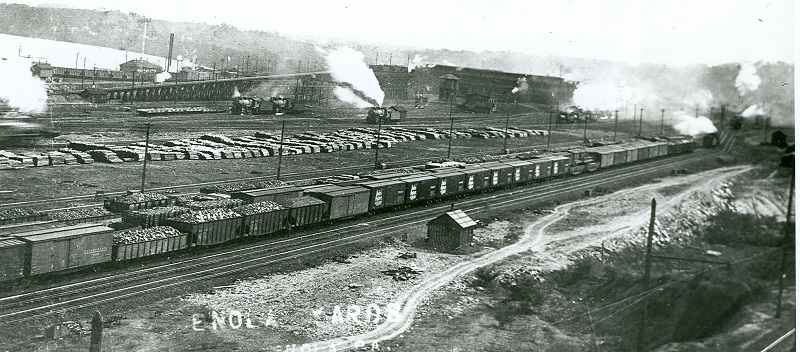The Pennsylvania Railroad (PRR) significantly expanded its infrastructure in the early 1900s to handle growing volumes of both freight and passenger traffic. Enola Yard, located at the intersection of major routes—including New England, the south, Baltimore, the Great Lakes, the eastern seaboard and the west--was built to serve as a hub for sorting freight cars between these routes.[1] The yard took its name from a flag stop on the Northern Central Railroad, named after the daughter of a local farmer who owned land along the line.[2]
The yard was built with funding provided by the Pennsylvania, Cumberland Valley, Philadelphia and Erie, and Northern Central Railroads, all components of the PRR.[3] Construction began in 1901 and the yard officially opened for service in January 1905.[4] Eventually the yard would grow to cover 316 acres, stretching for four miles along the Susquehanna River.
Trains of cars were shoved over artificial hills called ‘humps’ which caused them to roll by gravity for sorting on an array of yard tracks. Cars destined for different destinations were routed to selected tracks to be dispatched in later trains. Originally riders rode the cars down the hump and used the car’s handbrakes to slow them. This process was automated in 1944 with the use of ‘retarders’ that grabbed each cars wheels and slowed them to the proper speed for coupling to other cars on the selected track.[5]
At its peak around 1930 the yard could hold nearly 10,000 freight cars and scores of trains were dispatched each day. The highest number of cars ever handled was 20,661 cars in 1943.[6] In addition there was a large roundhouse that serviced steam locomotives and in 1923 a large car shop was built to assemble new freight cars.[7] In 1938, the portion of the yard near West Fairview was fitted with electric catenary to power electric freight trains in and out of the yard. Additional tracks were electrified in late 1957.[8]
With time freight cars were built to handle higher tonnages and became longer, as did train lengths with the introduction of diesel locomotives. Because Enola could not be expanded the PRR built a larger classification yard north of Pittsburgh (Conway) in the 1950s and much of Enola’s work was shifted there by 1957. Trains that used to be classified at Enola were now relayed directly to Conway instead.[9]
In 1976 Conrail was formed to take over the remaining lines of several northeastern railroads, including the Penn Central, the successor to the PRR. By the early 1980s changes in traffic patterns had resulted in the removal of the humps from Enola and lower traffic volumes, although a major diesel repair facility continued to operate there.
Enola Yard became the property of the Norfolk Southern Railroad (NS) in 1999. NS subsequently closed portions of Conway Yard, shifting the work to Enola. As a result one hump was reinstalled in the early 2000s.
Today the Enola Yard continues to be a busy place serving lines that radiate to all points of the compass. The diesel shop still services hundreds of locomotives every year and a small car repair shop is still in operation.
